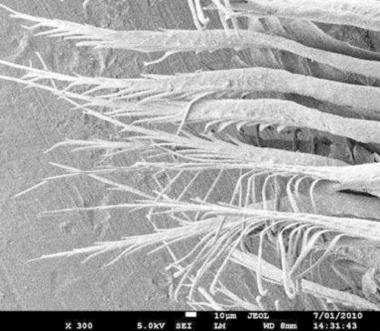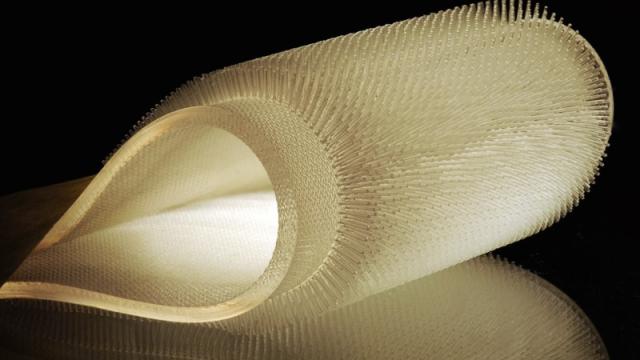Seals and otters stay warm in cold water because their fur is ideally structured for trapping insulating air. These unique hairy surfaces could inspire the design of new kinds of textiles, such as wet suits that are textured instead of smooth to keep divers warm in cold water.
MIT graduate student Alice Nasto described results from her group’s research into the water-repellant properties of fur and feathers last week at a meeting of the American Physical Society’s Division of Fluid Dynamics in Boston. They found that the geometry of certain furs and feathers — the length of the hair, and how far they were spaced apart — play a significant role in how well they repel water and insulate animals from the cold.
Seals, otters, and certain sea birds don’t have thick layers of body fat to protect them from the cold. Not only is a seal’s hair denser than other mammals, but it has a unique microstructure that keeps the hair tangled. This makes it easier to trap air between the hairs, and since air is less thermally conductive than water, it serves the same purpose as insulting layers of body fat.
For their experiments, the MIT team created an idealised fur (top image) from a soft silicone rubber material with laser cutting molds, so they could control the spacing and length of the hairs. They tested their plastic “fur coats” by dipping them in a fluid using a special apparatus to control the diving speed, varying that speed, the viscosity of the fluid, and hair density, among other aspects. They found that the denser and longer the hairs, the more water-repellent the fur proved to be.

Prior work in water-repellant materials has focused largely on the nanoscale structure, but it is challenging to make such materials in sufficiently large quantities to be commercially viable. Seal fur boasts similar water-repellant properties determined by structure at a larger scale (millimetres or even centimeters). So it would be much easier for materials scientists to make their own bio-ispired materials — new fabrics for wet suits, for instance.
The MIT research may also shed further light on how bats drink: they have hairy tongues that help them take up liquid when they drink, an example of capillary action in nature. The bat tongue has applications for dip coating in industry, Nasto said, particularly for coating objects that have textured rather than smooth surfaces. So her work could prove useful there, too.
There could be more to the story than insulating layers of air, however. Last year, Belgian and Moroccan researchers published a paper concluding that hairs in the coats of polar bears and the feathers of peacocks (see image above) reflect infrared light, thereby increasing how much their fur coats insulate against cold weather. That work could help improve building insulation.
References:
Nasto, Alice et al. “Keeping warm with fur in cold water: entrainment of air in hairy surfaces,” Presentation #L28.2, 68th Annual APS Division of Fluid Dynamics meeting, November 23, 2015.
Simonis, P. et al. (2014) “Radiative contribution to thermal conductance in animal furs and other woolly insulators,” Optics Express 22(2): 1940.
[Via APS Division of Fluid Dynamics]
Top image: An idealised model of fur. Credit: Felice Frankel. Bottom image: magnified barbules of a white peacock’s feather. Credit: Optics Express.
